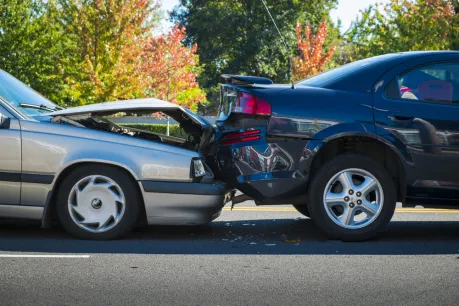Rear-Ended in a Crash? Know Your Legal Rights

Injured?
Rear-end collisions are some of the most common car accidents on the road. They can happen in a split second, at a red light, in stop-and-go traffic, or even while pulling into a driveway. While some crashes are minor fender benders, others lead to severe injuries that disrupt every aspect of a victim’s life.
If you’ve been hit from behind, you may be dealing with pain, medical bills, car repairs, and pressure from the other driver’s insurance company. But here’s the truth: If you were rear-ended, the crash likely wasn’t your fault, and you may be entitled to compensation.
How Rear-End Collisions Happen
Most rear-end accidents occur because a driver wasn’t paying attention, was speeding, or was following too closely. Common causes include:
Distracted Driving
One of the leading causes of rear-end collisions is distracted driving. Whether it’s texting, checking GPS directions, eating behind the wheel, or adjusting the radio, even a momentary lapse in attention can be enough to miss a slowing vehicle ahead.
Tailgating or Aggressive Driving
Drivers who follow too closely leave little room for error. Tailgating is especially dangerous in high-traffic areas where sudden stops are frequent. Aggressive drivers may swerve between lanes, brake abruptly, or pressure the vehicle in front, increasing the likelihood of a collision if traffic conditions change quickly.
Speeding in Heavy Traffic
Exceeding the speed limit, or simply driving too fast for conditions, reduces a driver’s ability to stop in time. In congested traffic, speeding dramatically shortens reaction time, increasing the likelihood of rear-end crashes. Even moderate speeding in areas with frequent stops or merging lanes can lead to chain-reaction collisions and serious injury.
Impaired Driving
Drivers under the influence of alcohol, drugs, or extreme fatigue have slower reflexes and poor judgment. Impairment affects depth perception, awareness, and the ability to respond to changing road conditions. A driver who is impaired may not notice brake lights ahead until it’s too late, resulting in a crash that could have been avoided with a clear mind and focused attention.
Poor Weather or Road Conditions
Rain, fog, ice, and snow can all reduce traction and visibility, making it harder to judge distance and stopping time. Rear-end collisions are common in poor weather, especially when drivers fail to slow down or maintain a safe buffer between vehicles. Roads with potholes or poor drainage also increase the risk of losing control or stopping short, both of which can contribute to rear-end crashes.
Failing to Account for Stopped or Slowing Vehicles
Drivers must always be prepared for sudden stops, whether due to traffic congestion, pedestrians, or red lights. When a driver is distracted, speeding, or otherwise not paying attention, they may fail to notice that the car in front has slowed or stopped entirely. In many cases, this simple failure to react in a timely manner is what leads to a rear-end collision.
Common Injuries After a Rear-End Crash
Injuries from rear-end accidents aren’t always visible right away. Some may take hours or days to develop, and what seems like minor soreness can evolve into a serious condition without treatment. Common injuries include:
- Whiplash, a soft tissue injury affecting the neck and shoulders
- Back and spine injuries, including herniated discs or nerve damage
- Head trauma, including concussions or traumatic brain injuries (TBIs)
- Facial injuries, from impact with the steering wheel or airbag
- Broken bones, especially in the hands, arms, or ribs
- Emotional trauma, including anxiety, PTSD, or fear of driving
If you’ve experienced any pain or discomfort after being rear-ended, it’s important to get a full medical evaluation, even if the symptoms seem mild at first.
Who’s At Fault in a Rear-End Accident?
In most rear-end crashes, the trailing driver is presumed to be at fault. Traffic laws require drivers to maintain a safe following distance and be prepared to stop at a moment's notice. If the driver behind you failed to do that, they may be considered negligent.
However, fault can sometimes be shared or disputed. The other driver’s insurer may claim that your brake lights weren’t working, that you stopped suddenly, or that road hazards played a role. That’s why documentation, photos, witness statements, and police reports are crucial.
What to Do After a Rear-End Collision
After a rear-end crash, your priority should be your health. Seek medical attention, even if you don’t think you’re seriously hurt. Then, protect your legal rights by taking the following steps:
- Document the accident scene (photos, license plates, road conditions).
- Get contact and insurance information from the other driver.
- File a police report, even for minor accidents.
- Keep all medical records, receipts, and communications related to the crash.
- Avoid giving statements to the other driver’s insurance company without legal guidance.
Once these steps are in place, speak to an experienced car accident attorney to understand your options.
Why Legal Representation Matters
Rear-end collisions may seem straightforward, but that doesn’t stop insurance companies from trying to minimize payouts or deny valid claims. The reality is, even when fault appears clear, insurers often use tactics to downplay injuries or shift blame onto the victim.
An experienced attorney can step in to protect your rights and make sure your claim is taken seriously. Legal professionals can help prove fault and establish liability through accident reports, expert analysis, and witness statements. They’ll also gather critical evidence and medical documentation to support the full extent of your injuries and losses.
From there, your attorney can handle negotiations with the insurance company, pushing back against lowball offers and working to secure fair compensation. That may include damages for medical expenses, lost wages, pain and suffering, and the long-term effects of your injury.
You shouldn’t have to fight this battle alone, especially when you were the one hit.
We’re For The People.
Rear-end collisions can cause more than just property damage; they can change lives. If you or a loved one was injured in a rear-end crash, Morgan & Morgan may be able to help. With over 35 years of experience and a team that fights For The People, not the powerful, we’ve recovered billions for accident victims nationwide.
If you were injured in a rear-end accident and the crash wasn’t your fault, you likely have a valid claim. Whether you’re facing physical recovery, mounting bills, or missed work, a Morgan & Morgan attorney can help you understand your rights and determine the value of your case.
Contact us today for a free, no-obligation case evaluation.

We've got your back
Injured?
Not sure what to do next?
We'll guide you through everything you need to know.